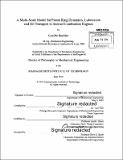A multi-scale model for piston ring dynamics, lubrication and oil transport in internal combustion engines
Author(s)
Baelden, Camille
DownloadFull printable version (36.12Mb)
Other Contributors
Massachusetts Institute of Technology. Department of Mechanical Engineering.
Advisor
Tian Tian.
Terms of use
Metadata
Show full item recordAbstract
Fuel consumption reduction of more than 20% can be achieved through engine friction reduction. Piston and piston rings contribute approximately half of the total engine friction and are therefore central to friction reduction efforts. The most common method to reduce mechanical losses from piston rings has been to lower ring tension, the normal force providing sealing between the piston ring and the cylinder liner. However tension reduction can result in additional lubricant consumption. The objective of this thesis is to understand and model the physical mechanisms resulting in flow of oil to the combustion chamber in order to achieve optimal designs of piston rings. The optimal design is a compromise between friction reduction and adequate gas and lubricant sealing performance. To do so a multi-scale curved beam finite element model of piston ring is developed. It is built to couple ring deformation, dynamics and contact with the piston and the cylinder. Oil flow at the interfaces between the ring and the cylinder liner and between the ring and the piston groove can thus be simulated. The piston ring model is used to study the sealing performance of the Oil Control Ring (OCR), whose function is to limit the amount of oil supplied to the ring pack. The contributions of the three main mechanisms previously identified, to oil flow past the OCR are quantified: - Deformation of the cylinder under operating conditions can lead to a loss of contact between the ring and the liner. - Tilting of the piston around its pin can force the OCR to twist and scrape oil from the liner. - Oil accumulating below the OCR can flow to the groove and leak on the top of the OCR The OCR is found to be flexible enough to limit the impact of cylinder deformation on oil consumption. Both ring scraping and flow through the OCR groove can contribute to oil consumption in the range of engine running conditions simulated. Reduction of scraping is possible by increasing the ability of both OCR lands to maintain contact with the liner regardless of piston groove tilt. The flow of oil through the OCR groove can be reduced by designing appropriate draining of oil in the groove and an adequate oil reservoir below the OCR. The piston ring oil transport model developed in this thesis will be a valuable tool to optimize ring pack designs to achieve further ring pack friction reduction without increasing oil consumption.
Description
Thesis: Ph. D., Massachusetts Institute of Technology, Department of Mechanical Engineering, 2014. Cataloged from PDF version of thesis. Includes bibliographical references (pages 215-218).
Date issued
2014Department
Massachusetts Institute of Technology. Department of Mechanical EngineeringPublisher
Massachusetts Institute of Technology
Keywords
Mechanical Engineering.